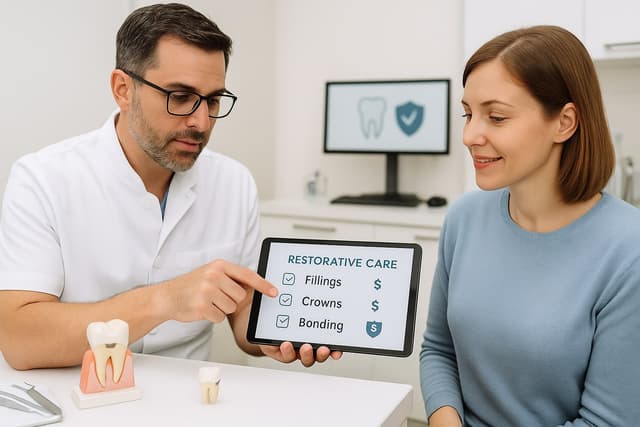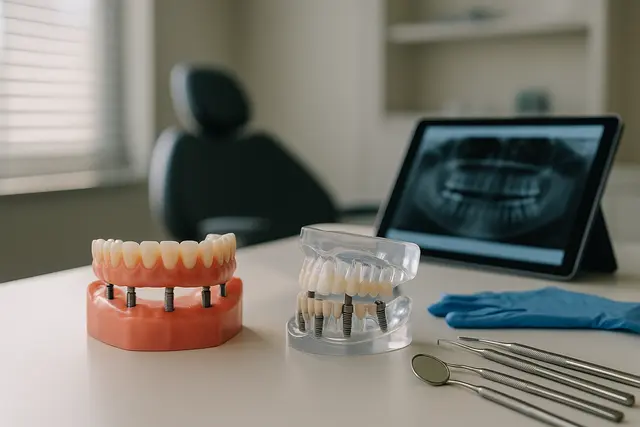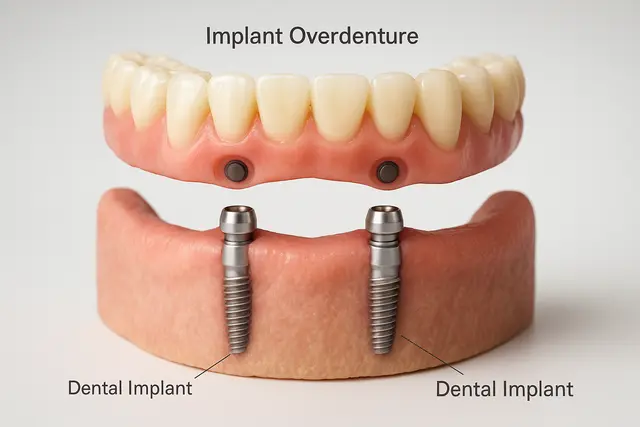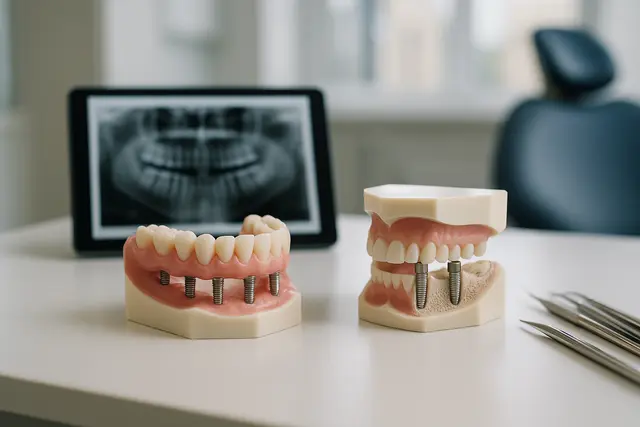Prosthodontics
5 min read
Jul 20, 2025
Dental Basic Restorative Services: Cost Coverage and Care Tips
Tooth troubles can strike when you least expect them, whether it’s a sudden crack or a sneaky cavity. Fortunately, restorative dental care offers solutions that not only repair the damage but also restore the health, function, and confidence in your smile.

If you’ve ever had a tooth crack on a popcorn kernel or found yourself wincing from a surprise cavity, you’re not alone. Life happens, and so does tooth trouble. But here’s the good news: restorative dental care is here to fix it all with skill, precision, and just enough polish to make your smile look brand new.
Whether it’s a small filling or a major restorative dental procedure like a crown or implant, knowing your options, costs, and care tips can save both your teeth and your wallet. Let’s break it down in a way that’s as easy to understand as a toothache is hard to ignore.
Restorative Dental Keeps Your Smile Functional and Confident
Restorative dental treatment isn’t just about looking good (though that’s a great bonus). It’s about keeping your natural teeth healthy, strong, and pain-free. Common restorative services include everything from dental fillings and crowns to dental implants and bridges. These procedures are essential dental tools used by your dentist to treat decay, damage, or missing teeth.
And don’t worry, if the word “restorative” sounds intimidating, it’s just a fancy way of saying “fixing stuff that’s broken in your mouth.”
Understanding Restorative Dentistry and Why It Matters
Restorative dentistry involves repairing or replacing damaged or missing teeth. The goal of restorative dentistry is to bring back function, comfort, and the appearance of your smile. So if you’re chewing only on one side or hiding your teeth in pictures, that’s your sign to explore your options.
The importance of restorative dentistry goes beyond vanity. Tooth decay, infection, and damage can mess with your ability to eat, speak, and enjoy life. A chipped tooth or infected pulp left untreated can lead to bigger issues, like losing more teeth or requiring major treatments like a root canal or even extraction.
Filling Options to Repair Cavities
A cavity is usually the first sign that something’s gone wrong. Left alone, it invites bacteria to throw a party in the pulp of your tooth, and nobody wants that.
Dental fillings are a go-to basic restorative dental procedure. Your dentist will clean out the decay and use dental restorative materials to restore the part of the tooth that was lost. These fillings can be tooth-colored for a more natural look or silver-colored if strength is more important than style (usually in the back teeth).
Need another reason to fix that cavity fast? Waiting could mean a root canal later.
Crown Solutions for Damaged or Weak Teeth
Now, if the decay or damage is more serious, a crown may be necessary. Dental crowns are like tiny helmets for your teeth. They cover and protect a weak or cracked tooth and restore function and appearance.
Use dental crowns when you’ve got a tooth that’s too broken for a filling but not bad enough for extraction. They’re common after root canal treatment or when a tooth is severely worn down.
Porcelain crowns are popular for front teeth because they look so natural, but other materials are available for tougher jobs in the back. And if that crown ever falls off, here’s what to know about emergency crown repair.
Root Canal Treatment for Infected Pulp
Here’s a phrase that scares many but saves even more: root canal therapy. When decay gets deep enough to reach the dental pulp, you’ll need more than a basic filling. Root canal treatment involves removing the infected pulp, cleaning the area, and sealing the tooth.
A root canal can save your natural tooth and avoid tooth extraction. Afterward, you’ll usually need a crown to fully protect the tooth.
Pro tip: Don’t ignore pain or swelling near a tooth, it could mean the pulp of your tooth is in trouble.
Dental Implant Options for Tooth Replacement
If a tooth can’t be saved, replacing it is your next best bet. Dental implants are a permanent, natural-feeling solution to replace missing teeth. An implant is a titanium post placed in your jawbone, topped with a crown that looks just like your real tooth.
Opt for implant-supported dentures if you’ve lost multiple teeth. They’re more secure than traditional dentures and can help preserve bone in your jaw.
A dental implant may seem like a major restorative option, but it's a long-term solution that pays off in comfort and confidence.
Dental Bridge and Denture Choices
Not ready for implants? A dental bridge can literally “bridge” the gap caused by one or more missing teeth. It’s anchored to the natural teeth or implants next to the space and helps restore your bite and smile.
Denture options range from partial dentures to full sets. Today’s dentures are more comfortable and natural-looking than ever. They're a smart choice for anyone dealing with multiple lost teeth or damaged teeth.
Cost of Basic and Major Restorative Dental Services
The cost of restorative dental care depends on the type of restorative you need, the materials used, and your insurance plan. Basic restorative dental services like cleanings, fillings, and simple crowns are usually covered more generously than major restorative dental services like dental implants or bridges.
Here’s a quick look:
Basic restorative: Fillings, cleanings, tooth-colored dental fillings
Major restorative: Crowns, bridges, implants, dentures, root canals
Most insurance plans divide restorative care into basic and major restorative dental categories. Your dental visits and procedures that require anesthesia or lab work are typically considered major dental restorative services. Always check what’s covered before you start dental work.
Care Tips After a Restorative Procedure
Caring for your teeth after a dental procedure is key. Here’s how to keep your restoration in great shape:
Don’t skip cleanings: Preventive dental care is just as important as fixing damage.
Brush and floss like you mean it: Especially around crowns and dental fillings.
Watch what you chew: Hard candy or ice can damage dental crowns or crack fillings.
Schedule regular dental visits: Catch dental problems before they need restorative dental treatment.
What Is Restorative Dentistry and Why Is It Important?
Restorative dentistry focuses on repairing or replacing damaged or missing teeth to restore function, comfort, and appearance. It’s essential not just for your smile, but for your ability to chew, speak, and maintain oral health long-term.
When Do I Need a Filling Versus a Crown?
You’ll likely need a filling if the decay is minor and the tooth structure is mostly intact. A crown is used when a tooth is too damaged or weak for a filling, it fully covers the tooth to protect and strengthen it.
What Are My Options If a Tooth Can’t Be Saved?
If a tooth is beyond repair, replacement options include dental implants, bridges, or dentures. Implants are a long-term, stable solution, while bridges and dentures can restore function and appearance with less invasive procedures.
How Can I Protect My Dental Work After a Procedure?
To maintain your restoration, brush and floss daily, avoid chewing hard objects, and keep up with regular dental visits. Good hygiene and preventive care are key to avoiding future damage and costly repairs.
Read Next
Related Posts

Prosthodontics
Implant Supported Dentures Overview
Missing teeth can impact more than just your smile, they can affect your confidence, comfort, and even your diet. Fortunately, modern dentistry offers a solution that’s both secure and natural-looking: implant-supported dentures. This innovative approach blends the stability of implants with the convenience of dentures to create a long-lasting, life-improving upgrade.
5 min read
Oct 29, 2025

Prosthodontics
Implant Overdentures Explained: The Hybrid Solution to Missing Teeth
Missing teeth can impact everything from your ability to eat to your self-confidence. While traditional dentures have long been a go-to solution, they often fall short in comfort and stability. Implant overdentures offer a modern alternative that combines the security of dental implants with the convenience of removable dentures, a true upgrade for those looking to reclaim their smile.
6 min read
Oct 29, 2025

Prosthodontics
Implant Retained Dentures Explained
Considering implant-retained dentures? You're not alone. As modern dentistry evolves, more people are turning to this secure, natural-feeling alternative to traditional dentures. This guide will walk you through what they are, how they work, and why they might be the solution you've been looking for.
4 min read
Oct 28, 2025
Don’t have time to research every dentist around you?
See why 30k+ patients trusted us